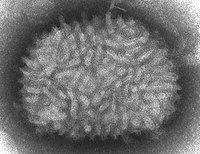
Photo from wikipedia
Previous studies have shown that E3-deficient vaccinia virus triggers apoptosis of infected cells. Our study demonstrates that this proapoptotic phenotype stems, at least in part, from the failure of the… Click to show full abstract
Previous studies have shown that E3-deficient vaccinia virus triggers apoptosis of infected cells. Our study demonstrates that this proapoptotic phenotype stems, at least in part, from the failure of the mutant virus to produce adequate quantities of the viral F1 protein, which acts at the mitochondria to directly block apoptosis. Our data establish a regulatory link between the vaccinia virus proteins that suppress the innate response to double-stranded RNA and those that block the intrinsic apoptotic pathway. ABSTRACT Poxviruses encode many proteins with the ability to regulate cellular signaling pathways. One such protein is the vaccinia virus innate immunity modulator E3. Multiple functions have been ascribed to E3, including modulating the cellular response to double-stranded RNA, inhibiting the NF-κB and IRF3 pathways, and dampening apoptosis. Apoptosis serves as a powerful defense against damaged and unwanted cells and is an effective defense against viral infection; many viruses therefore encode proteins that prevent or delay apoptosis. Here, we present data indicating that E3 does not directly inhibit the intrinsic apoptotic pathway; instead, it suppresses apoptosis indirectly by stimulating expression of the viral F1 apoptotic inhibitor. Our data demonstrate that E3 promotes F1 expression by blocking activation of the double-stranded RNA-activated protein kinase R (PKR). F1 mRNA is present in cells infected with E3-null virus, but the protein product does not detectably accumulate, suggesting a block at the translational level. We also show that two 3′ coterminal transcripts span the F1 open reading frame (ORF), a situation previously described for the vaccinia virus mRNAs encoding the J3 and J4 proteins. One of these is a conventional monocistronic transcript of the F1L gene, while the other arises by read-through transcription from the upstream F2L gene and does not give rise to appreciable levels of F1 protein. IMPORTANCE Previous studies have shown that E3-deficient vaccinia virus triggers apoptosis of infected cells. Our study demonstrates that this proapoptotic phenotype stems, at least in part, from the failure of the mutant virus to produce adequate quantities of the viral F1 protein, which acts at the mitochondria to directly block apoptosis. Our data establish a regulatory link between the vaccinia virus proteins that suppress the innate response to double-stranded RNA and those that block the intrinsic apoptotic pathway.
Journal Title: Journal of Virology
Year Published: 2018
Link to full text (if available)
Share on Social Media: Sign Up to like & get
recommendations!